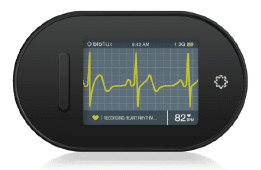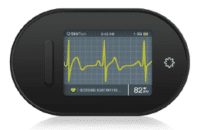
04 Oct Biotricity: Deep Data and AI Bring Enhanced Value to Medical Wearables
MedicalResearch.com Interview with:
Waqaas Al-Siddiq
Founder and CEO of Biotricity Inc
MedicalResearch.com: In light of Apple’s announcement that it will incorporate an EKG monitoring device into Apple watches in the near future, would you discuss your vision of the growing medical wearables market?
Response: First of all, the public is still largely confused as to what constitutes a medical wearable device. Apple’s new watch, with its EKG monitoring service, is not a medical wearable because it will not produce clinical-grade data needed for diagnosis or treatment. This is not to say that Apple’s watch isn’t helpful. Many people are not even aware that they have a heart problem, but if their Apple watch consistently tells them that they have an irregular heart rhythm, or arrhythmia, they could take that as a sign to go to a physician and get a professional diagnosis. A physician will then prescribe a medical wearable device, such as our Bioflux, to monitor the patient’s heart rhythm. Medical-grade wearable devices produce clinical-grade data that is accurate to within 90-95 percent or higher and are prescribed by physicians to make diagnoses and treatment plans.
That being said, I envision that the medical wearables market will expand considerably with the advent of consumer-based wearables that facilitate health tracking. One of the biggest problems we have today is a lack of awareness. Anywhere between 2.7 and 6.1 million people in the U.S. suffer from atrial fibrillation – a condition that makes the heart beat irregularly – and many aren’t aware that they have the condition. Consumer-based health trackers like the Fitbit and the Apple Watch can help raise awareness and alert consumers to possible health issues, which will encourage them to see a physician for a thorough and professional examination and diagnosis. This, in turn, gives the medical wearable market a boost as more people will be diagnosed with the aid of a medical wearable. Another factor that is playing into this adoption trend is that next-generation medical wearables are increasingly becoming smaller and easier to use for both patients and physicians. So, I think that the future of medical wearables will see them firmly entrenched in mainstream practice and eventually become tools within the home for individuals with chronic issues.
MedicalResearch.com: How will medical wearables potentially improve outcomes of chronic disease stats? Isn’t there a real possibility of expanded costs as patients report ‘false positives’ to their emergency room or health care providers? What are the malpractice repercussions?
Response: Medical wearables will reduce costs while enabling better health outcomes for chronic disease patients, both in the diagnostic and post-diagnostic stages. Medical wearables gather precise biometrics that aid in better diagnostics and post-diagnostic monitoring, so the fear that patients could report ‘false positives’ is actually more of a concern in scenarios where medical wearables don’t come into play or in the case of consumer-based health tracking devices. Just think of traditional doctor’s visits – patients will see their doctor for a half hour or so, during which any patient data gathered is restricted to the thirty minutes. If a doctor runs an ECG test during the visit, what are the chances that an arrhythmia just happens to occur during the test? A medical wearable that collects a patient’s ECG 24/7 in real time and in real-life settings is far more accurate, reliable, and able to catch a heart abnormality than any test that is done during an isolated office visit. Patients, too, are more likely to bring less-than-verified information regarding their health data to a doctor’s visit. Moreover, the advent of IoT will enable medical wearables to forward critical data to health care professionals for verification. This will be a secondary step to ensure costs do not rise. We are moving into the world of smart connected medical devices, those that have the ability to analyze and identify potential areas of intervention and forward this data for screening before any action is taken.
In terms of potential malpractice repercussions, they are negligent when weighed against the benefits of real-time, continuous remote monitoring. Medical wearables can detect events that would otherwise go unnoticed, literally saving lives in the process. Today, people are still heading to the emergency room when they feel poorly – whether or not their situation actually warrants an emergency visit. Next-generation medical wearables usually allow patients to hit an emergency button or manually record what they consider to be an adverse health “event.” With medical wearables, we can actually screen patients first by comparing what they report when they are experiencing an event against the data that is actually collected during this period. The result is improved triage, as we can save emergency center resources for those patients who actually require immediate intervention.
MedicalResearch.com: How will Biotricity use deep data and AI-enabled technology to reduce medical costs and diagnostic times?
Response: Biotricity’s focus on utilizing deep data and AI is to improve the diagnostic and post-diagnostic experience for both the physician and the patient. Our core focus is to use data and synthesize it to identify areas that are of interest to the physician; thereby, focusing the physician’s time and energy on the most important factors. On the patient side, our focus is similar but to drive the patient to be more engaged and compliant by showing them, through data, how their actions are improving their biometrics and condition. Deep data and AI would work in tandem in the background in both cases, continuously reorganizing the data to determine what trends are taking place and where action may be required.
We believe deep data and AI can bring value to medical wearables, further reducing medical costs and diagnostic times. When you have a medical wearable that is collecting data for diagnostic purposes, deep data and AI can review, analyze, and synthesize the data in a meaningful way through an interface that identifies data trends and pinpoints important information from which actionable insights can be gleaned. This in turn drives two things; reduced costs and improved diagnostic time. I would posit that patient outcomes will improve as an effect of the improvement in diagnostic time because you can start treating the patient faster. Implemented correctly, it will better allocate physician time and help them see more patients while delivering better care and outcomes.
On the post-diagnostic side, deep data and AI will be used not so much to provide a synthesized report to the physician but to provide physicians with a greater understanding of the patient’s condition over time. Is the patient’s condition improving, deteriorating, or remaining stable? Take a patient who is suffering from a heart condition. A medical wearable with deep data and AI capabilities could collect the data from the patient’s heart over a long period of time. For example, it could start by collecting basal metrics and factoring in patient history, and then measure how the heart is affected by physical activity, diet, stress, etc. The device could intervene if an adverse heart event occurs – alerting a call center or physician. It could simultaneously provide feedback and suggestions to the patient with regards to adjusting their daily routine or changing their lifestyle through more exercise or better food choices. On the one hand, this will significantly improve patient outcomes by providing them with feedback that they can act on, and by allowing physicians to intervene in a timely manner if necessary. On the other hand, it will allow physicians to focus more on the patients whose condition is not improving. Physician time is already a scarce commodity, so by allowing physicians to improve their workflow, medical wearables with deep data and AI are both reducing costs and improving patient outcomes.
MedicalResearch.com: Is there anything else you would like to add?
Response: There has been a lot of buzz around Apple’s recent announcement and what it means for the medical device space. Ultimately, I believe it is a step in the right direction and one that actually supports medical wearables as opposed to being disruptive to them. Improvement in patient outcomes is what we are focused on at Biotricity. Awareness is one of the biggest hurdles to improvement in outcomes and early intervention. Consumer health devices, when utilized and designed correctly to drive awareness, will get patients in front of a health care provider faster and earlier. At that point medical wearables can help diagnose and support that patient long term. In that regard, I may have a contrasting opinion to many in the field, because I believe this advancement will expand and open the market for medical wearables.
[wysija_form id=”3″]
[last-modified]
The information on MedicalResearch.com is provided for educational purposes only, and is in no way intended to diagnose, cure, or treat any medical or other condition. Always seek the advice of your physician or other qualified health and ask your doctor any questions you may have regarding a medical condition. In addition to all other limitations and disclaimers in this agreement, service provider and its third party providers disclaim any liability or loss in connection with the content provided on this website.
Last Updated on October 4, 2018 by Marie Benz MD FAAD


